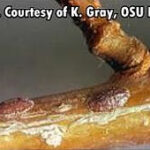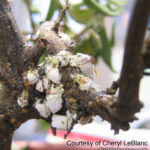Some Background
How They Become a Problem
Scales for the most part are sedentary creatures which are difficult to control — especially with sprays — as most have a natural talent for self-preservation. First of all most of these pests, at least as adults, permanently attach themselves to the plant or tree which plays host to them. Secondly, most are equipped with a protective covering, usually composed of waxy secretions forming either a shell of sorts or dense mat of waxy filaments or fuzz. These characteristics contribute to them being very troublesome and difficult to control.
Scale insects affect many different plants, shrubs and trees. Most herbaceous greenhouse crops — especially those whose production cycle is short, i.e. bedding plants-may never become afflicted with scale insects. More enduring crops such as tropical foliage, trees, etc., are far more likely to see these pests — especially if they are under duress. Most often we find that tropical interiorscape plantings fall victim to these pests. This is due to these plantings, as the name interiorscape suggests, being indoors and subjected to stresses which are not of the natural kind they are usually subjected to. In other words, if a tropical palm tree grown in the bright, warm and humid outdoor climate of Florida gets relocated to a dimly lit, stagnating, warm and dry climate in a Milwaukee, Wisconsin mall, it will be stressed and very likely to develop a scale insect infestation. It may, perhaps, come with some scale insects of its own which begin to take over when the plant becomes stressed as it tries to acclimate to its new surroundings. Very often, though, scales naturally present in Wisconsin will be drawn to these plants during the summer months as, to them, they probably look like easy-pickin’s and will therefore try to get to these plants. Outdoors, even in Wisconsin, natural enemies would normally keep scales in check-at least on native plants and trees. Where this often doesn’t work is in a situation where the scales or plants are not indigenous to the region, in which case may lack natural enemies and vigor.
Another situation where scale insects can become problematic may be in mass agriculture. Take, for instance, the citrus groves of Florida and California. These groves are often under a constant assault from pesticides, thus reducing the native population of biocontrol agents. If the sprays were not applied, assuming we’re talking about an indigenous pest, the natural enemies would, more often than not, be capable of restoring balance. Unfortunately, many growers will not allow this natural transition to take place as the lag time required for the natural enemies to play catch up could come at too high a cost. However, since many of the pests are from out-of-town, we’d have to also introduce out-of-town biocontrols. Just like that which was done to combat the cottony cushion scale.
Scales take up residence on fruits and stems and leaves — everywhere and anywhere. And as we wrote, they are well protected. In other words heavy spraying must be done in order to penetrate their defenses. Most of the spraying, it seems, does little good unless applied heavily enough to actually smother these insects, but which, of course, is often repelled by the waxy secretions. (Horticultural oil is a good remedy against scales if smothering is the cure de jour. Unfortunately it is not conducive to plant health as it smothers the plants as well.) This is why biocontrols are such a logical choice when it comes to battling these tenacious pests indoors. The tricky part is finding the right parasitoid or predator to do the job and allowing it enough time to work. If time is given and sprays not applied, natural enemies do work, especially, again, if the pest is indigenous.
If scales are not introduced by way of transportation of the pests with the plants, then they will come from the surrounding habitat — albeit slowly. Since only the adult males have wings it doesn’t seem likely or logical that they begin the infestation process. Our thought is the immature or crawler stages, which are mobile, slowly spread the population to other hosts. In addition to actually crawling, we suspect some hitch rides on water runoff, wind, people and animals and the like. Remember to scout new plant material thoroughly before bringing it into your greenhouse or interiorscape account. At least that may prevent the one factor which is most likely to spread these pests from ever occurring.
A Serious Pest

Scales can cause considerable economical damage They, like aphids, have a proboscis, stylet or straw-like mouthpart which they insert into the phloem or inner cells of a plant. Upon insertion the scales draw the plant’s juices or sap. This feeding activity generally goes unnoticed until the plant or tree begins to weaken and die. At this point the subject may be beyond the self-reparation stage. It is therefore imperative the scout notice the pests and begin corrective actions before the plant shows outward signs.

The presence of the scales will make a plant unsalable. Soft scales will appear as bark-colored bumps on the twigs and leaves generally. With close scrutiny, any quasi-talented scout will notice them. Mealybugs are typically whitish in color and can, too, be very noticeable. In addition to the mealybugs themselves, one may notice their cottony egg-masses-which are produced by most mealybug species, though not all (long-tailed mealybugs, for instance, reproduce viviparously, giving birth to live young making egg-masses obsolete). Armored scales are generally very small and are the most difficult to detect. However, in most interiorscape and greenhouse situations, we’ve found the most common scale insects are soft-scales and mealybugs. Though armored scales do indeed make their mark in these types of plantings, they generally seem to be more of a problem on citrus and other trees and shrubs.
